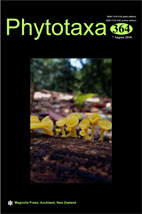Abstract
A taxonomic revision of A. caulialata is carried out in present study. It is lectotypified and epitypified, and the description of its leaf and inflorescence is revised. A new species, A. pseudocaulialata, from Yunnan, China, is also described and illustrated here. It is similar to A. caulialata in the shape of limb and color of throat, but can be distinguished by morphology of lamina and lobes of limb, and the length of anthers and gynostemium. The new species is also compared with A. faviogonzalezii and A. kwangsiensis, as they all have broadly ovate to suborbicular lamina. Whereas, A. pseudocaulialata differs from A. faviogonzalezii in the shape of limb, color of throat, and the length of capsule; differs from A. kwangsiensis in the color of limb, type of processes on the limb, the size of throat, and the length of capsule.
References
https://doi.org/10.1600/036364415X689140
Gong, Q.B., Landrein, S., Xi, H.C., Ma, X.D., Yang, Z.H., He, K.W. & Shen, J.Y. (2018) Aristolochia tongbiguanensis, a new species of Aristolochiaceae from Yunnan, China. Taiwania 63: 183–187.
https://doi.org/10.6165/tai.2018.63.183
González, F. (2012) Florística y sistemática filogenética innecesariamente disyuntas: El caso de Aristolochia, Euglypha y Holostylis (Aristolochiaceae). Revista de la Academia Colombiana de Ciencias Exactas, Físicas y Naturales 36: 193–202. [in Spanish]
Hwang, S.M., Kelly, L.M. & Gilbert, M.G. (2003) Aristolochia Linnaeus. In: Wu, Z.Y., Raven, P.H. & Hong, D.Y. (Eds.) Flora of China 5. Science Press, Beijing & Missouri Botanical Garden Press, St. Louis, pp. 258–269.
Liang, C.F. (1975) The Aristolochiaceae of Kwangsi Flora. Acta Phytotaxonomica Sinica 13 (2): 10–28. [in Chinese]
Linnaeus, C. von (1753) Species Plantarum 2. Impensis Laurentii Salvii, Holmiae [Stockholm], pp. 561–1200.
https://doi.org/10.5962/bhl.title.669
Ma, J.S. & Cheng, C.Y. (1989) New Taxa of Chinese Aristolochia L. Acta Phytotaxonomica Sinica 27: 293–297. [in Chinese]
Turland, N.J., Wiersema, J.H., Barrie, F.R., Greuter, W., Hawksworth, D.L., Herendeen, P.S., Knapp, S., Kusber, W.-H., Li, D.-Z., Marhold, K., May, T.W., McNeill, J., Monro, A.M., Prado, J., Price, M.J. & Smith, G.F. (2018) International Code of Nomenclature for algae, fungi, and plants (Shenzhen Code): Adopted by the Nineteenth International Botanical Congress Shenzhen, China, July 2011. Regnum Vegetabile 159. Koeltz Botanical Books, Glashütten, 254 pp.
https://doi.org/10.12705/Code.2018
Tao, D.D. (1997) Aristolochia Linnaeus. In: Chen, S.K. (Ed.) Flora Yunnanica 8. Science Press, Beijing, pp. 7–25. [in Chinese]
Thiers, B. (2018) Index Herbariorum: A global directory of public herbaria and associated staff. New York Botanical Garden’s Virtual Herbarium. Available from: http://sweetgum.nybg.org/ih/ (accessed 5 January 2018)
Wanke, S., González, F. & Neinhuis, C. (2006) Systematics of pipevines: Combining morphological and fast-evolving molecular characters to investigate the relationships within subfamily Aristolochioideae (Aristolochiaceae). International Journal of Plant Sciences 167: 1215–1227.
https://doi.org/10.1086/508024
Yang, B., Ding, H.B., Zhou, S.S., Zhu, X.X., Li, R., Mya, B.M. & Tan, Y.H. (2018) Aristolochia sinoburmanica (Aristolochiaceae), a new species from north Myanmar. PhytoKeys 94: 13–22.
https://doi.org/10.3897/phytokeys.94.21557
Zhu, X.X., Liao, S., Zhang, L., Wang, Z.H., Du, C. & Ma, J.S. (2016) The taxonomic revision of Asian Aristolochia (Aristolochiaceae) I: Confirmation and illustration of A. austroszechuanica, A. faucimaculata and A. yunnanensis var. meionantha from China. Phytotaxa 261 (2): 137–146.
https://doi.org/10.11646/phytotaxa.261.2.3
Zhu, X.X., Liao, S., Sun, Z.P., Zhen, A.G. & Ma, J.S. (2017a) The taxonomic revision of Asian Aristolochia (Aristolochiaceae) II: Identities of Aristolochia austroyunnanensis, A. dabieshanensis and A. hyperxantha—a new species from Zhejiang, China. Phytotaxa 313 (1): 61–76.
https://doi.org/10.11646/phytotaxa.313.1.4
Zhu, X.X., Liao, S., Ma, Z.X., Xu, B., Wang, Z.H., Wang, Y. & Ma, J.S. (2017b) The taxonomic revision of Asian Aristolochia (Aristolochiaceae) III: Two new taxa of Aristolochia and morphological revision for the flower character of A. obliqua from Yunnan, China. Phytotaxa 332 (3): 269–279.
https://doi.org/10.11646/phytotaxa.332.3.3

